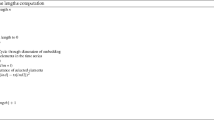Analysis of long time series is relevant in many current applications. These investigations are usually carried out on multiprocessor computers (supercomputers). However, supercomputer calculations are efficient only if the time-series processing algorithms are sufficiently parallelized. In this article, we propose a parallel algorithm that detects shift points of the time-series mean — a highly important task in many applications. The algorithm breaks the time series into segments and looks for shift points on each segment using a statistical test. The critical values have been calculated for this test. An additional test reduces the number of false detections.
Similar content being viewed by others
References
A. Ranganathan, “PLISS: Detecting and labeling places using online change-point detection,” Proc. of Robotics: Science and System VI (2010).
M. J. Lenardon and A. Amirdjanova, “Interaction between stock indices via changepoint analysis,” Appl. Stochastic Models Bus. Ind., 22, 573–586 (2006).
J. V. Braun, R. K. Braun, and H. G. Buller, “Multiple changepoint fitting via quasi-likelihood, with application to DNA sequence segmentation,” Biometrika, 87, No. 2, 301–314.
W. Shewhart, “The application of statistics as an aid in maintaining quality of a manufactured product,” Journal of the American Statistical Association, 20, 546–548 (1925).
E. S. Page, “Continuous inspection schemes,” Biometrika, 41, No. 1, 100–115 (1954).
A. N. Shiryaev, “The problem of the most rapid detection of a disturbance in a stationary process,” Soviet Mathematics—Doklady, 2, 795–799 (1961).
S. Roberts, “A comparison of some control chart procedures,” Technometrics, 8, 411–430 (1966).
M. Basseville and I. Nikiforov, Detection of Abrupt Changes: Theory and Application, Prentice-Hall, Englewood Cliffs, NJ (1993).
A. W. F. Edwards and L. L. Cavalli-Sforza, “A method for cluster analysis,” Biometrics, 21, No. 2, 362–375 (1965).
R. Killick, P. Fearnhead, and I. A. Eckley, “Optimal detection of changepoints with a linear computational cost,” Journal of the American Statistical Association, 107, No. 500, 1590–1598 (2012).
B. Jackson, J. D. Sargle, D. Barnes, S. Arabhi, A. Alt, P. Gioumousis, E. Gwin, P. Sangtrakulcharoen, L. Tan, and T. T. Tsai, “An algorithm for optimal partitioning of data on an interval,” IEEE Signal Processing Letters, 12, No. 2,105–108 (2005).
D. M. Hawkins, Peihua Qiu, and Chang Wook Kang, “The changepoint model for statistical process control,” Journal of Quality Technology, 35, No. 4, 355–366 (2003).
A. Sen and M. S. Srivastava, “On tests for detecting change in mean when variance is unknown,” Annals of the Institute of Statistical Mathematics, 27, 479–486 (1975).
H. Akaike, “Information theory and an extension of the maximum likelihood principle,” in: S. Kotz and N. L. Johnson (eds.), Breakthroughs in Statistics, Springer-Verlag, London, 1, 610–624 (1992).
R. Killick and I. A. Eckley, “Сhangepoint: An R package for changepoint analysis,” Journal of Statistical Software, 58, No. 3.
D. Schwarz, “Estimating the dimension of a model,” Annals of Statistics, 6, 461–464.
Author information
Authors and Affiliations
Corresponding author
Additional information
Translated from Prikladnaya Matematika i Informatika, No. 49, 2015, pp. 71–79.
Rights and permissions
About this article
Cite this article
Nikol’skii, I.M., Furmanov, K.K. Parallel Algorithm to Detect Structural Changes in Time Series. Comput Math Model 27, 247–253 (2016). https://doi.org/10.1007/s10598-016-9318-1
Published:
Issue Date:
DOI: https://doi.org/10.1007/s10598-016-9318-1




